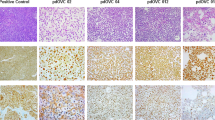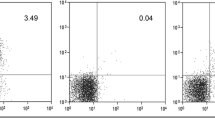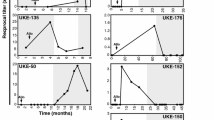Abstract
Sperm protein 17 (Sp17) is a cancer testis antigen that has been shown to be overexpressed in a variety of gynecologic malignancies, in particular ovarian cancer. Emerging evidences indicate that Sp17 is involved in tumorigenesis and in the migration of malignant cells. It has been proposed as a useful target for tumor-vaccine strategies and a novel marker to define tumor subsets and predict drug response. However, the antitumor activity of anti-Sp17 monoclonal antibody (anti-Sp17 mAb) has not been investigated. In this study, the in vitro cytotoxicity, antibody-dependent cell-mediated cytotoxicity (ADCC) and complement-dependent cytotoxicity (CDC) activities of anti-Sp17 mAb were evaluated using Sp17-positive ovarian cancer cells as targets, Sp17-negative ovarian cancer cells as the control, and healthy human peripheral blood monocytes and healthy human serum as effectors. Our preliminary results indicate that the direct cytotoxicity of anti-Sp17 mAb against the investigated ovarian cancer cells was very weak. However, the cytotoxicity of anti-Sp17 mAb, mediated by peripheral blood mononuclear cells (PBMCs), as ADCC, or by human serum, as CDC, was relatively strong in the Sp17-positive ovarian cancer cells. This finding suggested that anti-Sp17 mAb could be a useful tool against ovarian cancer and may provide insight into the development of low side-effect targeting therapy for this malignant disease.






Similar content being viewed by others

Abbreviations
- Sp17:
-
Sperm protein 17
- Anti-Sp17 mAb:
-
Anti-Sp17 monoclonal antibody
- ADCC:
-
Antibody-dependent cell-mediated cytotoxicity activity
- CDC:
-
Complement-dependent cytotoxicity
- CTA:
-
Cancer testis antigen
- CTL:
-
Cytotoxic T lymphocytes
- PBMCs:
-
Peripheral blood monocytes
- mCRPs:
-
Membrane complement regulatory proteins
- MAC:
-
Membrane attack complex
References
Jemal A, Siegel R, Xu J, Ward E. Cancer statistics, 2010. CA: Cancer J Clincians. 2010;60(5):277–300.
Kristedja TS, Morgan RJ, Cristea M. Targeted agents in ovarian cancer. Women’s Health (London, England). 2010;6(5):679–94.
Polakis P. Arming antibodies for cancer therapy. Curr Opin Pharmacol. 2005;5(4):382–7.
O’Rand MG, Widgren EE, Fisher SJ. Characterization of the rabbit sperm membrane autoantigen, RSA, as a lectin-like zona binding protein. Dev Biol. 1988;129(1):231–40.
Kong M, Richardson RT, Widgren EE, O’Rand MG. Sequence and localization of the mouse sperm autoantigenic protein, Sp17. Biol Reprod. 1995;53(3):579–90.
Lea IA, Kurth B, O’Rand MG. Immune response to immunization with sperm antigens in the macaque oviduct. Biol Reprod. 1998;58(3):794–800.
Lea IA, Richardson RT, Widgren EE, O’Rand MG. Cloning and sequencing of cDNAs encoding the human sperm protein, Sp17. Biochim Biophys Acta. 1996;1307(3):263–6.
McLeskey SB, Dowds C, Carballada R, White RR, Saling PM. Molecules involved in mammalian sperm-egg interaction. Int Rev Cytol. 1998;177:57–113.
Lacy HM, Sanderson RD. Sperm protein 17 is expressed on normal and malignant lymphocytes and promotes heparan sulfate-mediated cell–cell adhesion. Blood. 2001;98(7):2160–5.
Lim SH, Wang Z, Chiriva-Internati M, Xue Y. Sperm protein 17 is a novel cancer-testis antigen in multiple myeloma. Blood. 2001;97(5):1508–10.
Grizzi F, Gaetani P, Franceschini B, Di Ieva A, Colombo P, Ceva-Grimaldi G, et al. Sperm protein 17 is expressed in human nervous system tumours. BMC Cancer. 2006;6:23.
Straughn JM Jr, Shaw DR, Guerrero A, Bhoola SM, Racelis A, Wang Z, et al. Expression of sperm protein 17 (Sp17) in ovarian cancer. Int J Cancer. 2004;108(6):805–11.
Li FQ, Han YL, Liu Q, Wu B, Huang WB, Zeng SY. Overexpression of human sperm protein 17 increases migration and decreases the chemosensitivity of human epithelial ovarian cancer cells. BMC Cancer. 2009;9:323.
Li FQ, Liu Q, Han YL, Wu B, Yin HL. Sperm protein 17 is highly expressed in endometrial and cervical cancers. BMC Cancer. 2010;10:429.
Liu Q, Li FQ, Han YL, Wang LK, Hou YY. Aberrant expression of sperm protein 17 enhances migration of ovarian cancer cell line HO-8910. Nat J Androl. 2008;14(11):982–6.
Chiriva-Internati M, Weidanz JA, Yu Y, Frezza EE, Jenkins MR, Kennedy RC, et al. Sperm protein 17 is a suitable target for adoptive T-cell-based immunotherapy in human ovarian cancer. J Immunother. 2008;31(8):693–703.
Chiriva-Internati M, Yu Y, Mirandola L, Jenkins MR, Chapman C, Cannon M, et al. Cancer testis antigen vaccination affords long-term protection in a murine model of ovarian cancer. PloS one. 2010;5(5):e10471.
Li FQ, Zhang SX, An LX, Gu YQ. In vivo Molecular targeting effects of anti-Sp17- ICG-Der-02 on hepatocellular carcinoma evaluated by an optical imaging system. J Exp Clin Cancer Res. 2011;30:25.
Nimmerjahn F, Ravetch JV. Antibodies, Fc receptors and cancer. Curr Opin Immunol. 2007;19(2):239–45.
Natsume A, Niwa R, Satoh M. Improving effector functions of antibodies for cancer treatment: enhancing ADCC and CDC. Drug Design Dev Ther. 2009;3:7–16.
Li FQ, Yang AL, Miao JW, Zhang CH, Wu B, Zhang XH. Preparation and characterization of the monoclonal antibody against human sperm protein 17. Chin J Cellular Molecul Immunol. 2006;22(5):638–40.
Lin Y, Peng S, Yu H, Teng H, Cui M. RNAi-mediated downregulation of NOB1 suppresses the growth and colony-formation ability of human ovarian cancer cells. Medical Oncol (Northwood, London, England). 2011: [Epub ahead of print].
Adams GP, Weiner LM. Monoclonal antibody therapy of cancer. Nat Biotechnol. 2005;23(9):1147–57.
Richardson RT, Yamasaki N, O’Rand MG. Sequence of a rabbit sperm zona pellucida binding protein and localization during the acrosome reaction. Dev Biol. 1994;165(2):688–701.
Grizzi F, Chiriva-Internati M, Franceschini B, Hermonat PL, Soda G, Lim SH, et al. Immunolocalization of sperm protein 17 in human testis and ejaculated spermatozoa. J Histochem Cytochem. 2003;51(9):1245–8.
Wen Y, Richardson RT, Widgren EE, O’Rand MG. Characterization of Sp17: a ubiquitous three domain protein that binds heparin. Biochem J. 2001;357(Pt 1):25–31.
Grizzi F, Chiriva-Internati M, Franceschini B, Bumm K, Colombo P, Ciccarelli M, et al. Sperm protein 17 is expressed in human somatic ciliated epithelia. J Histochem Cytochem. 2004;52(4):549–54.
Chiriva-Internati M. Sperm protein 17: clinical relevance of a cancer/testis antigen, from contraception to cancer immunotherapy, and beyond. Int Rev Immunol. 2011;30(2–3):138–49.
Zhang Y, Wang Z, Robinson WR, Lim SH. Combined real time PCR and immunohistochemical evaluation of sperm protein 17 as a cancer-testis antigen. Eur J Haematol. 2004;73(4):280–4.
Pisani F, Maini CL, Sciuto R, Dessanti L, D’Andrea M, Assisi D, et al. FCR (Fludarabine, Cyclophosphamide, Rituximab) regimen followed by 90Yttrium ibritumomab tiuxetan consolidation for the treatment of relapsed grades 1 and 2 follicular lymphoma: a report of 9 cases. J Exp Clin Cancer Res. 2011;30:16.
Idusogie EE, Presta LG, Gazzano-Santoro H, Totpal K, Wong PY, Ultsch M, et al. Mapping of the C1q binding site on rituxan, a chimeric antibody with a human IgG1 Fc. J Immunol. 2000;164(8):4178–84.
Crowe JS, Hall VS, Smith MA, Cooper HJ, Tite JP. Humanized monoclonal antibody CAMPATH-1H: myeloma cell expression of genomic constructs, nucleotide sequence of cDNA constructs and comparison of effector mechanisms of myeloma and Chinese hamster ovary cell-derived material. Clin Exp Immunol. 1992;87(1):105–10.
Wang W, Wang EQ, Balthasar JP. Monoclonal antibody pharmacokinetics and pharmacodynamics. Clin Pharmacol Ther. 2008;84(5):548–58.
Lencer WI, Blumberg RS. A passionate kiss, then run: exocytosis and recycling of IgG by FcRn. Trends Cell Biol. 2005;15(1):5–9.
Lazar GA, Dang W, Karki S, Vafa O, Peng JS, Hyun L, et al. Engineered antibody Fc variants with enhanced effector function. Proc Natl Acad Sci USA. 2006;103(11):4005–10.
Cartron G, Dacheux L, Salles G, Solal-Celigny P, Bardos P, Colombat P, et al. Therapeutic activity of humanized anti-CD20 monoclonal antibody and polymorphism in IgG Fc receptor FcgammaRIIIa gene. Blood. 2002;99(3):754–8.
Cartron G, Watier H, Golay J, Solal-Celigny P. From the bench to the bedside: ways to improve rituximab efficacy. Blood. 2004;104(9):2635–42.
Geis N, Zell S, Rutz R, Li W, Giese T, Mamidi S, et al. Inhibition of membrane complement inhibitor expression (CD46, CD55, CD59) by siRNA sensitizes tumor cells to complement attack in vitro. Curr Cancer Drug Targ. 2011;10(8):922–31.
Hourcade D, Liszewski MK, Krych-Goldberg M, Atkinson JP. Functional domains, structural variations and pathogen interactions of MCP, DAF and CR1. Immunopharmacology. 2000;49(1–2):103–16.
Davies A, Lachmann PJ. Membrane defence against complement lysis: the structure and biological properties of CD59. Immunol Res. 1993;12(3):258–75.
Donin N, Jurianz K, Ziporen L, Schultz S, Kirschfink M, Fishelson Z. Complement resistance of human carcinoma cells depends on membrane regulatory proteins, protein kinases and sialic acid. Clin Exp Immunol. 2003;131(2):254–63.
Niwa R, Sakurada M, Kobayashi Y, Uehara A, Matsushima K, Ueda R, et al. Enhanced natural killer cell binding and activation by low-fucose IgG1 antibody results in potent antibody-dependent cellular cytotoxicity induction at lower antigen density. Clin Cancer Res. 2005;11(6):2327–36.
Gelderman KA, Kuppen PJ, Okada N, Fleuren GJ, Gorter A. Tumor-specific inhibition of membrane-bound complement regulatory protein Crry with bispecific monoclonal antibodies prevents tumor outgrowth in a rat colorectal cancer lung metastases model. Cancer Res. 2004;64(12):4366–72.
Hong F, Yan J, Baran JT, Allendorf DJ, Hansen RD, Ostroff GR, et al. Mechanism by which orally administered beta-1, 3-glucans enhance the tumoricidal activity of antitumor monoclonal antibodies in murine tumor models. J Immunol. 2004;173(2):797–806.
Acknowledgments
The authors appreciate Liu Qi, PhD for the gift of SKOV3 and COC2 human ovary carcinoma cell lines. Funding support: This work was supported by a grant from National Nature Science Foundation of China (No. 81101978).
Conflict of interests
The authors declare that they have no conflict of interests.
Author information
Authors and Affiliations
Corresponding author
Rights and permissions
About this article
Cite this article
Song, Jx., Cao, Wl., Li, Fq. et al. Anti-Sp17 monoclonal antibody with antibody-dependent cell-mediated cytotoxicity and complement-dependent cytotoxicity activities against human ovarian cancer cells. Med Oncol 29, 2923–2931 (2012). https://doi.org/10.1007/s12032-011-0137-0
Received:
Accepted:
Published:
Issue Date:
DOI: https://doi.org/10.1007/s12032-011-0137-0



